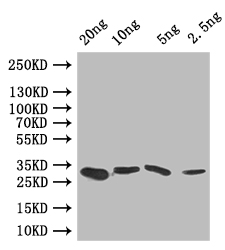The generation of polyclonal antibodies against GRE2 includes iterative immunizations of a rabbit using recombinant Saccharomyces cerevisiae (strain ATCC 204508 / S288c) (Baker's yeast) GRE2 protein (1-120aa). Following the attainment of a satisfactory antibody titer, the rabbit undergoes bleeding, and antibodies are isolated from the serum and then purified using affinity chromatography. The efficacy of the GRE2 antibody is assessed through ELISA and WB applications, demonstrating reactivity with Saccharomyces cerevisiae (strain ATCC 204508 / S288c) (Baker's yeast) GRE2 protein.
The Saccharomyces cerevisiae GRE2 plays an essential role in cellular metabolism and detoxification processes. Possessing NADPH-dependent oxidoreductase activity, GRE2 contributes to cellular redox balance, maintaining homeostasis by participating in electron transfer reactions. Notably, GRE2 is involved in the detoxification of various compounds, particularly aldehydes and reactive intermediates, playing a protective role in shielding the cell from potential damage.







